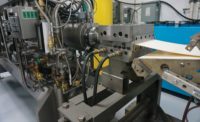The national unemployment rate (nonfarm payroll employment) declined to 5.9% in September, according to the U.S. Bureau of Labor Statistics’ monthly employment report. Areas seeing job growth were professional and business services, retail trade (including food and beverage stores) and health care. Most people view the slow but steady decline in the U.S. unemployment rate as good for the country as a whole. But for employers in industries struggling to find skilled workers—such as the baking industry—a shrinking labor pool and more job opportunities in other fields could make hiring even more challenging.
“It’s ongoing,” says Kent Van Amburg, executive director, American Society of Baking (ASB), Kansas City, MO, regarding the shortage of qualified workers in the baking industry. “It’s a problem that’s been recognized by the industry for a long time.”
The shortage primarily is in two areas, Van Amburg explains: “One is in production bakers, bakery engineers, bakery scientists—the people who actually manage production in a plant. The other is on the mechanical side—the people who can actually work on the equipment and fix things when they go wrong.”
David Van Laar, president, Biscuit & Cracker Manufacturers’ Association (B&CMA), Columbia, MD, agrees that there is a shortage of qualified workers in the industry, especially in the technical fields. “Several of our members are expanding their operations and looking for qualified employees,” he says. “They’re hiring employees new to the food business and must train them thoroughly on food-safety procedures.”
Haley Thomas, director of sales and marketing, Ballreich Bros. Inc., Tiffin, OH, believes many industries across the country are having difficulty finding qualified workers. “We’re not exempt from that,” she adds. “With the higher level of skilled positions in demand in the food industry due to SQF (Safe Quality Food) and the increasing food-safety and quality initiatives, it’s just going to continue to increase. And as the industry gets better, it’s going to demand more skilled and more qualified people.”
Employee deterrents
So why is there dearth of qualified workers in the baking industry? Are people uninterested in the field or simply unaware of the career opportunities it offers?
One of the reasons people may not be gravitating toward the industry is the work itself, says Van Amburg. “There are long hours,” he explains. “You work weekends and holidays. It’s in a factory-type setting. You’re not working in an office or sitting behind a computer doing creative work or something.”
An aging population is also impacting the industry’s labor supply. “The people who trained at the American Institute of Baking as baking professionals are now in their mid to late 50s,” says Van Amburg. “They’re retiring at a faster and faster rate, and they’re just not being replaced.”
And then there’s a lack of schools offering relevant programs. “There’s only one real university program, and that is at Kansas State University,” says Van Amburg. “It has a baking and science degree program, but it’s very limited by the number of professors, equipment and facilities it has. It’s graduating less than 30 people a year, and they all get jobs while they’re in school. They’re snatched up right away.”
In addition, some people are unaware that KSU even offers such a program. “A lot of times, students who end up in the program started in something else,” says Van Amburg. “They hear about it once they’re at KSU.”
Thomas agrees that there just aren’t many universities offering food-science-related degrees. The Ohio State University in Columbus, which, she notes, has a great food science and technology department and degree, is several hours from the company’s Tiffin facility, a deterrent for some job candidates.
And once students find a college that offers a food science or related program, they often gravitate toward research and development, quality assurance, electronics and other popular areas.
The American Bakers Association (ABA), Washington, D.C., and ASB announced last month that they have hired a research firm to conduct a comprehensive research study on the employment skills gap in the U.S. commercial baking industry. Its findings are expected to be released in fall 2015.
Fostering tomorrow’s workforce
Well aware of the workforce issues facing their members, industry associations are trying different tactics to attract employees now and in the future.
For instance, ASB created posters promoting the baking industry as a profession and sent them to its members to distribute to high schools in their area, says Van Amburg. The association also provides several scholarships each year, as do several other industry associations.
Van Laar says B&CMA is beginning to work with youth groups to foster interest in the baking industry. “Baking contests conducted through groups such as 4-H and school programs may spark interest in students,” he adds.
Eli’s Cheesecake Co., Chicago, has been involved with the Chicago High School for Agricultural Sciences for more than 20 years, says Marc Schulman, president of the company. “It’s only one of a few high schools in the country located on a farm dedicated to food, food science and life sciences,” he says, adding that his company has not had any difficulty finding workers.
Schulman is also involved in FARM Illinois, an initiative that promotes competitiveness and sustainable growth in food, agriculture and agribusiness in Illinois, serving as co-chair on the Innovation, Education and Workforce Development Committee. “I believe education is one of the only things that everybody can agree on,” he says. “It’s hard for us to share our R&D and other practices with other people, but having a more-educated workforce is important to everyone.”
Educating today’s workers
While it’s encouraging that industry associations and members are building interest in the baking industry among tomorrow’s workforce, many bakers need qualified workers now. Training programs offered by numerous industry associations are helping them address this issue in the interim.
“AIB has embarked on an ambitious multiyear program to renovate its courses, so that we not only stay current with industry, but so that our learning products are tailored to meet the needs of today’s learners,” explains Susan Hancock, vice president for learning and communications, AIB International, Manhattan, KS.
For instance, AIB recently completed the Cookie and Cracker modules of its foundational Baking Science and Technology Course (BS&T). The modules now feature more application-based instruction, so participants spend approximately 30% of the module in the classroom and 70% focusing on application-oriented activities in the baking laboratories. “By renovating our materials to meet the needs of today’s learners, we are hoping to help bring more people into the baking industry, in addition to preparing them well for the profession,” Hancock adds.
B&CMA is continually looking for ways to expand its educational offerings and meet the changing needs of the industry, says Van Laar. The organization offers an online Entry-Level Training Course that trains new employees on the basics of food safety. An online Intermediate Training Course provides specialized training for specific operations in the bakery. The Cookie and Cracker Manufacturing Course, the mainstay of the B&CMA training program, is a correspondence course designed to develop the professional bakers of the future. Students have up to two years to complete the course, which requires written tests and laboratory experiments. B&CMA is also developing programs to provide internships for food-science students with its members.
ASB, meanwhile, recently introduced a Product Development Competition to promote the development of innovative bakery products for the wholesale manufacturing industry. “We’re promoting it within food technology departments at different universities,” says Van Amburg. The winners will be announced in March at BakingTech 2015 in Chicago.
Also, some companies have in-house training programs, allowing them to train people in specific areas and move them up through their organizations.
Retaining workers
“Continued training and opportunities for advancement are key to retention and development,” maintains Van Laar. “Several industry professionals began their career on the production floor. In one company, for instance, the director of operations, plant manager, product managers and shift managers were all developed internally.”
In addition to training, Ballreich Bros. enables employees who live in large, nearby cities to work from home, so it can find and retain more qualified workers from a larger pool of candidates, says Thomas. The company also has a college reimbursement program that reimburses a portion of workers’ tuition. “It’s tiered, so you have to be here so many years and you have to stay here so many years after you complete your degree,” she explains. “It does help us retain and educate our current employees.”
Finding workers hasn’t been an issue for Golden Cannoli Shells Co., Chelsea, MA. “Our fathers did a great job creating a legacy,” says Valerie Bono, owner and director of national sales for the company. She notes that many of the employees that started with her dad 30 to 40 years ago are still with the company, with many who have been there for over 20 years. “These people are so valuable,” she says, “and we cherish their passion and love for the business.”
Besides offering employees a family atmosphere in which to work and training, Golden Cannoli rewards workers with events, prizes, gifts and time off. Next year, it will begin offering English classes. Bono notes that it’s important that the employees are as knowledgeable as possible. The company also plans to hire a full-time human resources manager soon to integrate more worker training.
Even though Eli’s Cheesecake has been OK in terms of finding workers, the company doesn’t take this for granted. “I think when you do that, you’re not prepared for changes,” says Schulman. “We went through a time in this country when there weren’t as many job opportunities. Today, people have more choices, so you want to position yourself as an employer of choice and not just a place people have to be.”








